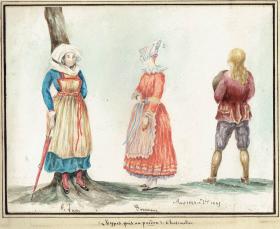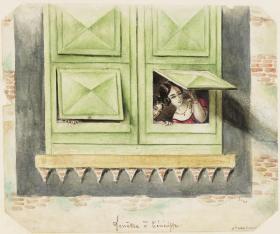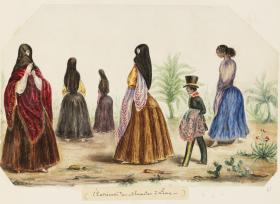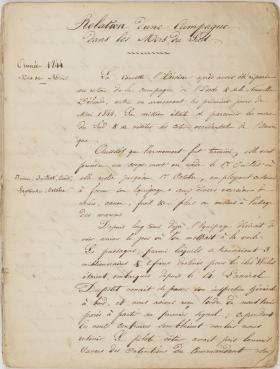One of the benefits of the Library’s online ‘Ask a Librarian’ service is that we can answer questions about our collections from anywhere in the world, like a query that arrived from north-western France in late 2015. Historians at the University of Rennes were researching the background of an album of watercolours by nineteenth century sailor-artist Félix Marant-Boissauveur, recently discovered in Brittany.
Through our catalogue they had found that the Library held a set of albums which may have been by the same artist. A comparison of the images confirmed that we do indeed hold the world’s only other known works by the enigmatic Marant-Boissauveur.
The three albums of pencil and watercolour drawings, ‘Voyage of the French Corvette l’Héroïne, 1844–1849’, were bequeathed by Sir William Dixson in 1952 alongside the manuscript journal ‘Relation d’une Campagne dans les Mers du Sud, May 1844– January 1849’, which describes the journey of l’Héroïne from the perspective of a sailor.
It is unlikely that an international audience would have any knowledge of these volumes were it not for their discovery by Patrick O’Reilly, former secretary-general of the Société des Océanistes, in 1977. He had been visiting Sydney for three weeks and, having a few hours spare before returning home, decided to leaf through the Library’s holdings on marine vessels: logbooks, narratives of shipwrecks and illustrations.
O’Reilly came across the albums of watercolours by Marant-Boissauveur and the shipboard journal attributed to him, and spent the afternoon perusing their contents. He published an article on his findings in the September 1979 edition of Bulletin de la Société des Études Océaniennes.
Well-known for its Oceania collections, the Library contains a number of volumes on French Pacific expeditions, including official accounts of the voyages of Nicolas Baudin (1800–1804), Louis de Freycinet (1817–1820), Louis Isidore Duperrey (1822–1825) and Jules Dumont D’Urville (1826–1829). Unlike most of the drawings that accompany these accounts, however, the illustrations by Félix Marant-Boissauveur are not the work of an official artist. They are the everyday observations of a ship’s purser (treasurer), recording the people and landscapes of port cities visited by l’Héroïne.
Both the Brittany and l’Héroïne albums display a mix of quick pencil sketches, impressions of landscapes, and playful, finely detailed character studies. The l’Héroïne albums pick up in 1844 where the Brittany album concludes, when the artist leaves France and embarks on the long voyage on board the corvette.
In Marant-Boissauveur’s character studies we see his talent for depicting costume detail. Compare, for example, two scenes (shown here) from very different places: two women and a man in the Brittany album, Types pris au pardon de Châteaulin (August 1844), and a group of ladies in Lima, Peru, l’Extrémité des Alamedas â Lima (March 1845).

The Châteaulin drawings show two modestly dressed women. The folds of their dresses and the gathering of their aprons are rendered in shaded colour. Both have small feet in black, pointed shoes with buckles. One woman, in blue, faces us while the other, in orange, turns her head away. The man, in a coat of deep purple with gold edging, has his back turned, showing us his long golden hair. He holds his hat to his chest.
The Lima scene follows a similar composition. The colour and texture of the women’s outfits are shown in rich detail, and their small, pointed feet are seen peeking out from beneath floor-length skirts. The women appear very tall, with generous bustles.
The accompanying journal — until recently attributed to Marant-Boissauveur — provides a counterpart to the watercolour albums, with detailed descriptions of life at sea and on land. It was rewritten after the expedition from notes that may no longer exist. Its donor, Sir William Dixson, saw sufficient value in the journal to translate it from French to English in his own hand.
We learn early on that its author is an anonymous low-ranking sailor (with the slight privilege of being the Lieutenant’s secretary). He describes his close friendship with the artist:
Being young and not having a very strong liking to sea life, the Purser (Mr Boissauveur) had only come on this voyage to satisfy his craving to visit distant countries, to study the customs of their inhabitants, and at the various ports of call, to make use of his skill in drawing and painting, at which he was very good. It was very fortunate for me that, when tired of walking unsteadily on the deck, I could go down into the ward room and make sketches together with this worthy friend. There I would forget I was on a ship, we chatted about our relations just as if we were two brothers …
The author’s descriptions of everyday shipboard routine are those of a young, inexperienced sailor, missing home, comfort and family. He is often cold, wet and hungry, and must endure not only the ravages of weather but the sudden deaths of a number of his shipmates. He writes philosophically about the hierarchy on board the ship and the relationships between himself and his colleagues. Of the officer in command, he writes, ‘This man uses his power in a way to make you hate a condition that is hard even for him, but which is made much worse by the numerous vexations a sailor has to put up with.’
He details the backbreaking tasks a sailor must complete — such as regularly holystoning (polishing with a soft sandstone) the deck — and the constant taunts, humiliation and punishments meted out by superiors and shipmates for the smallest infractions.
On the longed-for occasions when the corvette moors at port cities — such as an extended stay in Valparaiso — the author’s lowly status ensures a long wait between arriving at port and being allowed to leave the ship. Once ashore, however, he delights in a reprieve from physical labour and enjoys the fresh fruit and vegetables available on land. He also observes the local costumes and cultures.
The recent discovery of the Félix Marant-Boissauveur album in Brittany and the enquiries from French scholars have brought to light a gem of nineteenth century travel illustration. Coupled with the manuscript journal, we have a fascinating unofficial account of a French Pacific voyage through the eyes of a sailor and a purser.
Anna Corkhill
Curator, Research and Discovery




